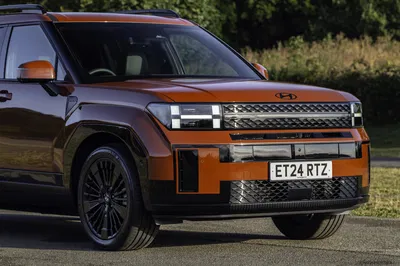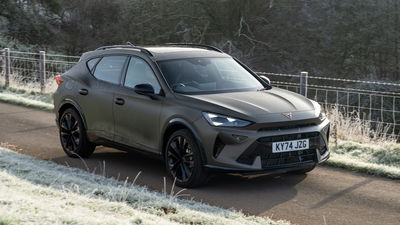2024 Hyundai Santa Fe Review: The Ultimate Automotive Glow-Up

Pros
- Does everything you'd want a big family bus to do......and looks great doing it
Cons
- No diesel optionPricier than most rivals
Quite a few long-running car models have debuted rather bold new looks in the last couple of years – just look at the new Toyota Prius. We’re not sure anything tops the fifth-gen Hyundai Santa Fe, though. If you can describe a single feature of any of the first four generations, then frankly, you probably work for Hyundai.
However, as the Santa Fe approaches a quarter-century on sale (yes, really), Hyundai has decided it should look like what we thought an SUV from the 2020s might have looked like in the 1980s.
The Korean firm has been rather good at this lately. The Ioniq 5 and 6 introduced us to the company’s emboldened approach in the UK, but it’s not all that surprising from cars that are supposed to signal a brave new electric future. You need just look at some of the more ‘normal’ cars it sells in other markets, like the Staria MPV and Grandeur saloon, to see that Hyundai’s design mojo isn’t limited to its EVs – and the Santa Fe is more evidence of that.

That’s all lovely, but good design can only take it so far. Underneath, it’s related to the outgoing Santa Fe, and still a very sensible car – a big, seven-seater family SUV. Its striking looks are for nowt if it can’t do that job properly.
Here in the UK, we get two powertrains, both electrified and both rooted around a 1.6-litre turbocharged petrol four-cylinder. There’s an old-school, ‘self-charging’ hybrid with 212bhp and either front- or all-wheel drive; and a plug-in hybrid, four-wheel drive only and making a peak of 250bhp. All versions are mated to a six-speed automatic, top out at 112mph, and have 0-62mph times in the nine-point-something-second region.

Time will tell if Hyundai’s been wise not to offer a diesel. It may have about as bright a future as an automotive fuel as steam, but a big SUV that people might tow with is one of the few places a nice, torquey diesel still makes genuine sense.
The powertrains it has, though, are good’uns – responsive, smooth, and adequately grunty, despite even the front-drive Santa Fe weighing a smidge over two tonnes. The engine only ever gets vocal if you really clog it, and the gearbox is always responsive and slick. There are paddles if you feel the need to take control, but you probably won’t.

It’s a remarkably efficient thing. Despite a shape inspired by the Southbank Centre, Hyundai’s managed to keep the drag coefficient at a remarkably low 0.29 – considerably lower than the much blobbier old Santa Fe.
As a result, you won’t have too much of an issue getting MPG well in the 30s, even once you’ve pushed the PHEV’s relatively modest battery capacity to its limit.
It helps that it’s not exactly a car that goads you into pushing it. It rarely lacks oomph, steers and handles neutrally and progressively, and slows predictably and smoothly. Driving-wise, that’s literally all you can ask for in a car like this. Start pedalling hard, as precisely none of its owners will, and it starts to understeer and loll about like you’d expect.

With comfy seats, a commanding driving position, and wonderful all round visibility, the Santa Fe is a car to relax and watch the world go by in – and it’s very good for this. Hyundais having good interiors stopped being a surprise a while ago, but this is one of the best – everything looks and feels expensive, and the design nicely echoes the outside’s boxy aesthetic.
You get a subtly curved display ahead of you that incorporates two 12.3-inch screens – a digital instrument cluster and an infotainment display. The latter is well laid out and easy to navigate, but far more importantly, you’ve got proper shortcut buttons down on the centre console as well as physical dials for heating and ventilation.
It strikes a good balance between decluttering the dash and over-relying on the screen. The only slight letdown is the haptic pad that handles things like heated seats and fan speed – it’s not the easiest thing to decipher. Still better than using a screen, though.

There’s loads of storage, a pair of ventilated phone charging pads and, most intriguingly, a sterilisation tray above the glovebox. Pop something in here and, 10 minutes later, it comes out sanitised via a combination of UV light and, presumably, witchcraft. This came about while the car was being designed (largely via VR) during the height of Covid, but it’ll undoubtedly appeal to anyone using a Santa Fe to cart around kids and the smorgasbord of germ-coated stuff they come with. Shame an actual child won’t fit in it.
Boxes, you'll note, are rather practical things, so because the Santa Fe’s shaped like one, it’s massively roomy in all directions. Things are a bit more snug than you might expect in the second row with a tall driver up front, but you could still very comfortably get four adults in. As always, the third row isn’t really designed for grown-ups, but even then, they’ve got more space than some other seven-seaters.

All the rear seats fold flat, leaving 992 litres of luggage space (985 in the PHEV) and enough room (just) for a six-footer to lie comfortably – I can vouch for this, having slept in the Santa Fe on its launch (everyone did – Hyundai didn’t forget to book me a hotel).
Kipping atop a Welsh mountain in some particularly Cambrian weather also really highlighted just how well-insulated it is from the outside world – not that this isn’t apparent when driving, where the odd bit of tyre roar is the biggest intrusion into the cabin’s serenity.

Price-wise, the Santa Fe runs from £46,775 for a front-drive car in the entry-level Premium trim (which still gets plenty of kit), up to £57,635 for a PHEV in the posh Calligraphy spec. For an extra £1,000, you can get a six-seater Calligraphy, with the middle bench swapped out for very reclinable captain’s chairs.
That price pushes it into more premium territory than rivals like the Skoda Kodiaq, Peugeot 5008, and (related) Kia Sorento but a Hyundai competing in this arena shouldn’t really be a surprise anymore – it unquestionably feels like a high-end product. At this price point, it competes with seven-seaters like the Mercedes GLB and Discovery Sport – both much smaller, older cars. Not as good-looking, either.

However, despite some obvious differences, the seven-seater the Santa Fe reminds me of most is the VW ID Buzz. Like that car, it’s a superbly practical, comfy family bus, but its brilliant design elevates it from a car you buy because you have to, to one you might actually buy because you want to.















Comments
No comments found.